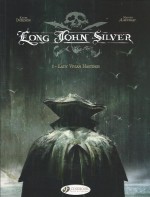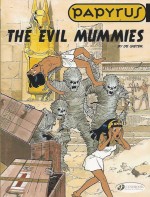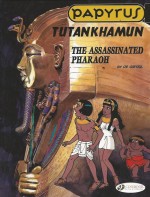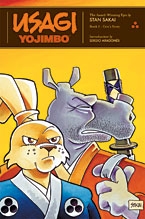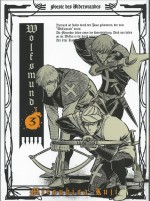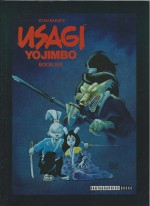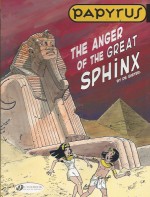
By Lucien De Geiter, coloured by Georges Vloeberghs & translated by Erica Jeffrey (Cinebook)
ISBN: 978-1-84918-115-0
Papyrus is the rapturously beguiling masterwork of Belgian cartoonist Lucien de Gieter. It premiered in 1974 in legendary weekly Spirou, running to more than 30 albums and consequently spawned a wealth of merchandise, a television cartoon show and a video game.
De Gieter was born in 1932 and studied at Saint-Luc Art Institute in Brussels before going into industrial design and interior decorating. He made the jump into sequential narrative in 1961, first through ‘mini-récits’ (fold-in, half-sized booklets) inserts for Spirou, starring his jovial cowboy ‘Pony’, and later by writing for art-star regulars such as Kiko, Jem, Eddy Ryssack and Francis.
He later joined Peyo’s studio as inker on ‘Les Schtroumpfs’ (The Smurfs) and took over the long-running newspaper strip ‘Poussy’.
In the 1960s De Gieter launched mermaid fantasy ‘Tôôôt et Puit’ whilst Pony was promoted to the full-sized pages of Spirou, deep-sixing the Smurfs to expand his horizons by going to work for Tintin and Le Journal de Mickey.
From 1972-1974 he assisted cartooning legend Berck on ‘Mischa’ for Germany’s Primo, whilst his newest project: a historical confection which would occupy his full attention and delight millions of fervent fans for the following four decades.
The annals of Papyrus encompass a huge range of themes and milieux, mixing Boy’s Own adventure with historical fiction, fantastic fantasy and interventionist mythology: the epic yarns gradually evolving from traditional “Bigfoot†cartoon style and content towards a more realistic, dramatic and authentic iteration. Moreover each tale readily blended light fantasy escapades with the latest historical theories and discoveries.
Papyrus is a fearlessly forthright young fisherman favoured by the gods who quickly rises to become a hero of Egypt and friend to Pharaohs. As a youngster the plucky Fellah was singled out and given a magic sword courtesy of the daughter of crocodile-headed Sobek.
The youthful champion’s first task was to free supreme deity Horus from imprisonment in the Black Pyramid of Ombos thereby restoring peace to the Double Kingdom, but his most difficult and seemingly never-ending duty is to protect Pharaoh’s wilful, high-handed and insanely danger-seeking daughter Theti-Cheri – a princess with an astounding knack for finding trouble …
The Anger of the Great Sphinx is the fifth Cinebook translation (20th album of the series and originally released in 1997 as La Colère du grand Sphinx); a spooky testing of faith through vile supernatural villainy eventually thwarted by unflinching daring and honest devotion…
The eerie escapade opens when restless Papyrus discovers the princess sleepwalking in the corridors of Pharaoh’s great Palace in Memphis. Cautiously following, he trips over court jester Puin and by the time he recovers his feet Theti-Cheri has seized a waiting chariot and hurtled into the dark desert beyond the gates.
Extremely alarmed, the lad leaps astride Puin’s phenomenally intelligent donkey Khamelot and rushes after her…
In the bleak wastes Papyrus is attacked by a living sandstorm threatening to end the line of Pharaohs, but successfully drives it off with his magic sword, just as terrified Puin catches up. As the sun rises they see that they are near the venerable complex of pyramids and Re Harmakhis, Guardian of the Horizon.
The mighty monuments and the Great Sphinx are all but buried under the eternally shifting sands…
Nervous Puin wants to return to the city, leaving such great concerns to Pharaoh and the gods, but Papyrus refuses to abandon the mesmerised princess who can be seen between the paws of the great statue. As he approaches, the stone beast roars that Theti-Cheri now belongs to him because her father has broken an ancient pact to keep the sands from covering him and his temples.
As assign of his dissatisfaction, the princess will die at sunset…
Desperate for a solution, the boy hero agrees to give the insidious sandstorm his magic sword if it will save the princess and the swirling devil advises the lad to find Anty, the Divine Ferryman and seek passage to the Island of the Gods where he can petition the Divinities for merciful intervention…
Dashing to the Nile with Puin and Khamelot in hot pursuit, Papyrus is forced to match wits with the duplicitous Ferryman – a conniving talking crocodile boat with a grudge against the boy from previous encounters.
Once again the rogue vessel tries to cheat and bamboozle the boy. Whilst ostensibly taking the trio to the gods’ home, Anty plies the humans with a hallucinogenic drink (resulting in a stunning and baroque display of the author’s spectacular imagination and artistic virtuosity) before leaving them unconscious in a bed of reeds.
Here they are discovered by trio of sibling dotards – dubbed Pepi I, Pepi II and Pepi III – who minister to them. They are in turn saved by Papyrus when bullying brigands try to rob their hovel. The elders are fishermen now but once they were paid by Pharaoh to keep the Sphinx and pyramids clear of sand.
In recent years though they appear to have been forgotten…
With horror the boy realises they have been left back near the Sphinx and the day is fast fading. With ho hope left of gaining the gods’ aid he rushes off to find Anty and teach the conniving Ferryman the error of his wicked ways before returning to hand his wonderful sword over to the smugly triumphant sandstorm…
At his most despondent moment, through the roaring sand Papyrus sees the Pepis. The elderly janitors have organised the entire village: young and old alike are toiling amid the storm to clear the Sphinx for the sake of their beloved princess.
When Khamelot inadvertently reminds the frantically labouring peasants of a tried-and-true way to dampen down the swirling grains and make them more manageable, the furiously screaming storm devil is at last beaten and blows away…
In the quiet still morning the Sphinx is again free from obstruction and obscurity, but Papyrus is heartbroken to see that it is all too late.
Carrying the corpse of Theti-Cheri into the desert he denies his faith, screaming at the gods who have been so unfair… and they answer, revealing the foolish mistake the passionate, impatient lad has made…
With the princess joyously restored and Re Harmakhis gleaming in all his golden glory Pharaoh at last arrives in a blare of trumpets to reaffirm his dynasty’s obligations and devotion to the gods, elevating the three Pepis to the exalted station of Eternal Guardians of the Sphinx. The newly appointed opponents of the shifting sands have recently taken possession of a certain magic sword and gratefully return it to the boy who restored their family fortunes…
Epic, chilling, funny, enthralling and masterfully engaging, this is another amazing adventure to thrill and beguile lovers of wonder from nine to ninety-nine, again proving Papyrus to be a sublime addition to the family-friendly pantheon of continental champions who wed heroism and humour with wit and charm, and anybody who has worn out those Tintin and Asterix albums would be wise beyond their years to add these classic chronicles to their dusty, wellbeloved bookshelves.
© Dupuis, 1997 by De Gieter. All rights reserved. English translation © 2012 Cinebook Ltd.

